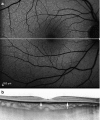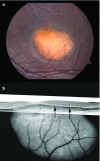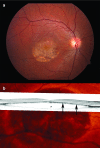BEST1: the Best Target for Gene and Cell Therapies
- PMID: 26388462
- PMCID: PMC4700113
- DOI: 10.1038/mt.2015.177
BEST1: the Best Target for Gene and Cell Therapies
Abstract
A retinal pigmented epithelial (RPE) disorder, bestrophinopathy has recently been proven to be amenable to gene and cell-based therapies in preclinical models. RPE disorders and allied retinal degenerations exhibit significant genetic heterogeneity, and diverse mutations can result in similar disease phenotypes. Several RPE disorders have recently become targets for gene therapies in humans. The year 2011 brought a new advance in cell-based therapies, with the Food and Drug Administration approving clinical trials using embryonic stem cells for an RPE disorder known as age-related macular degeneration. Recent studies on induced pluripotent stem (iPS)-RPE generation indicate strong potential for developing patient-specific disease models in vitro, which could eventually enable personalized treatment. This mini-review will briefly highlight the suitability of the retina for gene and cell therapies, the pathophysiology of bestrophinopathy, and the research and treatment opportunities afforded by stem cell and genetic therapies.
Figures





Similar articles
-
Induced Pluripotent Stem Cell Modeling of Best Disease and Autosomal Recessive Bestrophinopathy.Yonsei Med J. 2020 Sep;61(9):816-825. doi: 10.3349/ymj.2020.61.9.816. Yonsei Med J. 2020. PMID: 32882766 Free PMC article.
-
BEST1 gene therapy corrects a diffuse retina-wide microdetachment modulated by light exposure.Proc Natl Acad Sci U S A. 2018 Mar 20;115(12):E2839-E2848. doi: 10.1073/pnas.1720662115. Epub 2018 Mar 5. Proc Natl Acad Sci U S A. 2018. PMID: 29507198 Free PMC article.
-
Mutation-Dependent Pathomechanisms Determine the Phenotype in the Bestrophinopathies.Int J Mol Sci. 2020 Feb 26;21(5):1597. doi: 10.3390/ijms21051597. Int J Mol Sci. 2020. PMID: 32111077 Free PMC article.
-
Bestrophinopathy: An RPE-photoreceptor interface disease.Prog Retin Eye Res. 2017 May;58:70-88. doi: 10.1016/j.preteyeres.2017.01.005. Epub 2017 Jan 19. Prog Retin Eye Res. 2017. PMID: 28111324 Free PMC article. Review.
-
Gene and Induced Pluripotent Stem Cell Therapy for Retinal Diseases.Annu Rev Genomics Hum Genet. 2019 Aug 31;20:201-216. doi: 10.1146/annurev-genom-083118-015043. Epub 2019 Apr 24. Annu Rev Genomics Hum Genet. 2019. PMID: 31018110 Review.
Cited by
-
Attenuation of Inherited and Acquired Retinal Degeneration Progression with Gene-based Techniques.Mol Diagn Ther. 2019 Feb;23(1):113-120. doi: 10.1007/s40291-018-0377-1. Mol Diagn Ther. 2019. PMID: 30569401 Free PMC article. Review.
-
Clinical Features and Genetic Findings of Autosomal Recessive Bestrophinopathy.Genes (Basel). 2022 Jul 4;13(7):1197. doi: 10.3390/genes13071197. Genes (Basel). 2022. PMID: 35885980 Free PMC article.
-
BESTROPHIN1 mutations cause defective chloride conductance in patient stem cell-derived RPE.Hum Mol Genet. 2016 Jul 1;25(13):2672-2680. doi: 10.1093/hmg/ddw126. Epub 2016 May 18. Hum Mol Genet. 2016. PMID: 27193166 Free PMC article.
-
Adeno-Associated Viral Gene Therapy for Inherited Retinal Disease.Pharm Res. 2019 Jan 7;36(2):34. doi: 10.1007/s11095-018-2564-5. Pharm Res. 2019. PMID: 30617669 Free PMC article. Review.
-
Expression and Purification of Mammalian Bestrophin Ion Channels.J Vis Exp. 2018 Aug 2;(138):57832. doi: 10.3791/57832. J Vis Exp. 2018. PMID: 30124653 Free PMC article.
References
-
- 1Friedman, DS, O'Colmain, BJ, Muñoz, B, Tomany, SC, McCarty, C, de Jong, PT et al.; Eye Diseases Prevalence Research Group. (2004). Prevalence of age-related macular degeneration in the United States. Arch Ophthalmol 122: 564–572. - PubMed
-
- 2Rosenberg, EA and Sperazza, LC (2008). The visually impaired patient. Am Fam Physician 77: 1431–1436. - PubMed
-
- 3Bainbridge, JW, Smith, AJ, Barker, SS, Robbie, S, Henderson, R, Balaggan, K et al. (2008). Effect of gene therapy on visual function in Leber's congenital amaurosis. N Engl J Med 358: 2231–2239. - PubMed
Publication types
MeSH terms
Substances
Supplementary concepts
Grants and funding
LinkOut - more resources
Full Text Sources
Other Literature Sources
Medical

